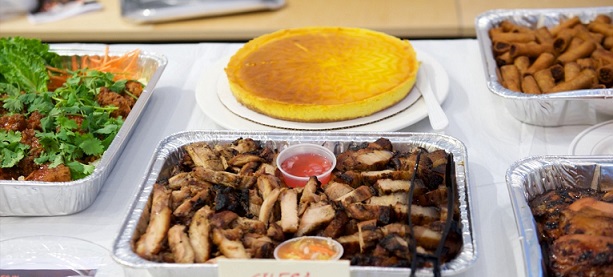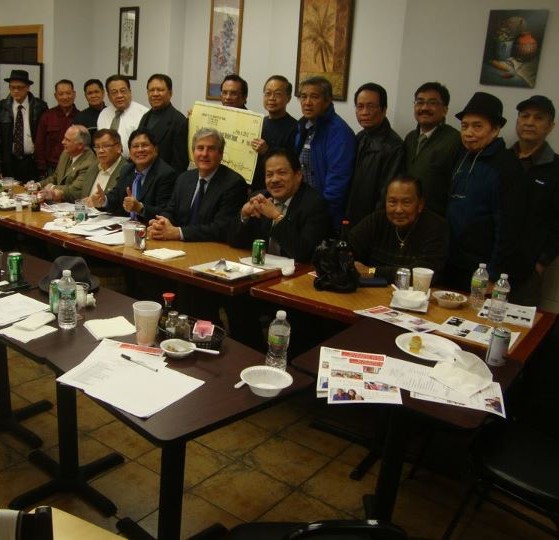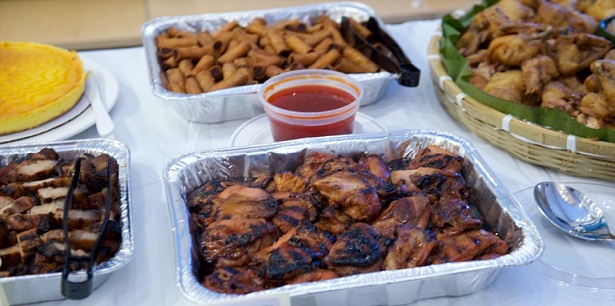Filipino food: Tops in taste ‘but not pretty on the table’

Trays of dishes and desserts courtesy of the participating restaurants in Filipino Restaurant Week, May 11 to 23. Photos by Boyet Loverita
With lavish patriotic pride, we declare Filipino food to be the best in taste. But we also wonder: Why hasn’t the Kare Kare crossed over to mainstream American tables the way General Tso’s Chicken has?
About 20 restaurant owners and chefs who gathered recently to launch Filipino Restaurant Week — from May 11 to 23 — offered a plethora of theories. Some said presentation comes up short, others bewailed that Filipino food is not healthy. And if you’re wondering why some restaurants have busier traffic than others, it’s probably because they have clean toilets!
“People love the Filipino taste, it’s just not pretty on the table,” said Faye San Agustin, floor manager at La Parrilla de Manila in Colonia, New Jersey.
Tyrone Conshue, who co-owns Pinoy Filipino Restaurant in Somerville, New Jersey, with his Filipina wife Cynthia, said some eateries highlight the Balut or the Dinuguan but not so much the more appealing food that brings out the color and flavor of the islands.
“We need to see the beauty in our own food,” he said.
Rose Teves, owner of Grill 21 in Manhattan, and Miriam Averilla, owner of Calesa Restaurant and Bakeshop in Union, New Jersey echoed the need to “improve the presentation” to make Filipino dishes look more appealing.
Foodie and marketing professional Kat Popiel of Food Innovation Group said she was hoping the Filipino Adobo would have been a culinary hit by now because many of her American friends like it. She noted the similarities between Filipino and Mexican cuisine, such as the Adobo and the Ceviche, suggesting how food south of the border appeared to have made more of an impact on U.S. culinary culture.
“I’m surprised that Adobo has not crossed over,” she said. “Maybe we will see more of it.”
Consul General Mario de Leon Jr. weighed in, saying presentation is an important “business decision” restaurant owners make to target their market. He said, as an example, that Filipinos do not usually mind eating fish and shrimp served with the heads. But to some non-Filipinos who are fidgety about seeing fish heads on their plates, owners need to adjust to make the food more acceptable. “It’s all a business decision,” he said.
He noted how Filipino dishes are not much different from traditional Asian spread that make generous use of salt and vinegar both as flavoring and preservative.
Romy Dorotan, chef and owner of Purple Yam in Brooklyn, said Filipino food should “get away” from the pork-heavy dishes, like the Kare Kare, the Sisig, or the Lechon roasted pig.
“Filipino food can be healthy food,” he said. “We have vegetables and seafood that have nutritional value.” He said too that restaurants should start promoting healthy eating the way Filipino dishes truly were back in the day.
Consul General De Leon said Filipino Restaurant Week, now on its second year, has definitely grown. There are now more participating restaurants representing New York’s four boroughs and some coming from the towns of Elizabeth, Somerville, Union and Colonia in New Jersey.
“We are expanding,” he said. “We are excited doing it again this year.”
He said Filipino food has acquired a reputation over the years, from traditional home-style to cutting-edge fusion. Filipino Restaurant Week would continue to promote the country’s unique gastronomic experience offering “a glimpse into what Filipino identity and culture is about,” he added.
For Nicole Ponseca, her identity was the spark behind the ‘kamayan’ or utensil-free dinners at Maharlika Filipino Moderno and Jeepney Filipino Gastropub in Manhattan, a dining trend that caught on in other restaurants.
“I remember my dad eating Balut and Dinuguan and eating with his hands,” said Nicole. “I was so embarrassed.”
She said Maharlika and Jeepney are “an homage to everything that we (Filipinos) are embarrassed about.”
Here’s a list of participating Filipino restaurants and their prix-fixe menu.

Restaurant owners and chefs with Consul General Mario de Leon Jr. SEATED: King Phojanakong of Kuma Inn and Tito King’s Kitchen, foodie Kat Popiel, Nicole Ponseca of Maharlika and Jeepney, De Leon Jr., Miriam Averilla of Calesa, Nenet Roldan of Max’s of Manila, and Cynthia Conshue of Pinoy Filipino Restaurant. STANDING: Aris Tuazon of Ugly Kitchen, Faye San Agustin and Jay San Agustin of La Parrilla, Rena Avendula of Payag, Cherry Castellvi of Kabayan, Manny Imperial of Sisig City and Fil-Am Kusina, Mario Albenio of Tito Rad’s, and Romy Dorotan of Purple Yam.













Great site and I look forward to seeing it expand over time.